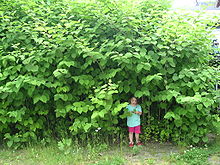Fallopia
- Fallopia as described by de Loureiro is a synonym of Grewia. "Fallopia" is also the name of a character on the TV show Saul of the Mole Men.
| Fallopia | |
|---|---|

| |
| Fallopia dumetorum - from Thomé, Flora von Deutschland, Österreich und der Schweiz, 1885 | |
| Scientific classification | |
| Kingdom: | |
| Division: | |
| Class: | |
| Order: | |
| Family: | |
| Genus: | Fallopia |
| Species | |
|
See text | |
Fallopia is a genus of about 12–15 species of flowering plants in the family Polygonaceae, often included in a wider treatment of the related genus Polygonum in the past. The genus is native to temperate and subtropical regions of the Northern Hemisphere. The genus includes herbaceous perennial plants, herbaceous vines, and woody vines.
Several species are serious invasive weeds, notably Japanese knotweed in Europe and North America (see below).
The genus is named after Gabriello Fallopio, or Fallopius, who was the superintendent of the botanical garden at Padua. He was also an acclaimed anatomist, being considered a founder of modern anatomy along with Vesalius and Eustachius.
Fallopia species are used as food plants by the larvae of some Lepidoptera species including Coleophora therinella (recorded on F. convolvulus).
Species
- Fallopia baldschuanica Russian vine; mile-a-minute vine; China fleece vine; fleece flower; silver lace vine (syn. Fallopia aubertii, Polygonum baldschuanicum, Polygonum aubertii). Eastern Asia.
- Fallopia cilinodis fringed black bindweed (syn. Polygonum cilinode, Bilderdykia cilinodis). North America.
- Fallopia convolvulus Black-bindweed (syn. Polygonum convolvulus, Bilderdykia convolvulus). Europe, Asia, northern Africa.
- F. convolvulus var. subalatum
- Fallopia cynanchoides (syn. Polygonum cynanchoides). Western China.
- Fallopia dentatoalata (syn. Polygonum dentatoalatum). Eastern Asia.
- Fallopia denticulata (syn. Polygonum denticulatum). Southern China.
- Fallopia dumetorum copse bindweed (syn. Polygonum dumetorum, Bilderdykia dumetorum). Europe, Asia, northern Africa.
- Fallopia forbesii (syn. Polygonum forbesii). Northern China, Korea.
- Fallopia japonica Japanese knotweed (syn. Polygonum cuspidatum, Polygonum japonicum, Polygonum reynoutria, Reynoutria japonica). Eastern Asia.
- F.japonica var. compacta
- F.japonica var. compacta f. rosea Hort.
- Fallopia multiflora (syn. Polygonum multiflorum). Eastern Asia.
- F. multiflora var. hypoleuca
- Fallopia polystachyum.
- Fallopia pterocarpa (syn. Polygonum pterocarpum). Southern Asia.
- Fallopia sachalinensis giant knotweed (syn. Polygonum sachalinense, Reynoutria sachalinensis). Eastern Siberia.
- Fallopia scandens. North America.
Hybrids
Crosses between Japanese knotweed and giant knotweed have occurred where the two species grow in close proximity. The hybrid, Fallopia × bohemica (syn. Polygonum × bohemicum) is known as Bohemian knotweed.
Fallopia × conollyana (F. baldschuanica × F. japonica) is called railway-yard knotweed.
Invasive species

Many knotweed species, particularly Japanese knotweed, giant knotweed and Himalayan knotweed are considered noxious, invasive pests. Like many such weeds, Japanese knotweed was introduced from Japan first into the U.K., then into North America in the 19th century as an ornamental plant.
Some knotweeds grow extremely quickly during the spring; giant knotweed can reach 4.5 m by summer, Japanese knotweed 3 m, and "dwarf" Himalayan knotweed 1.5–2 m. In Japan, Japanese knotweed is known as itadori, or "strong plant". Some species can spread rapidly from an extensive network of rhizomes (roots that can sprout) spreading from 7–20 m from the parent plant and at least 2 m deep. Root and stem fragments as small as 1 cm can form new plant colonies. Floods and high water events wash whole or partial plants into rivers and creeks, dispersing pieces of knotweed throughout the flooded area and banks, which give rise to new plants. As with other invasive species of plants, freshly disturbed soil allows the rapidly growing young knotweed plants to outgrow other plants and take over the area, suppressing other species. Cutting, mowing, digging and some herbicide treatments, especially in early to mid growing season, fail to curb knotweed growth and in fact often stimulate the production of shoots from latent buds dispersed on the root crown or rhizomes.
Medicinal properties
Recently, Japanese knotweed (Fallopia japonica, syn. Polygonum japonicum, Polygonum cuspidatum, Reynoutria japonica) and others have been used to exploit their high concentrations of trans-resveratrol in the plants' stalks. Previously associated with and identified mainly in the skins of red grapes, resveratrol is currently under study in a number of research projects investigating its reputedly powerful antiaging properties.
Japanese knotweed is being used to treat cancer.
External links
- Species Profile - Japanese Knotweed (Fallopia japonica), National Invasive Species Information Center, National Agricultural Library. Lists general information and resources for Japanese knotweed.
- Japanese Knotweed Alliance (UK)
- Recipes from "Wildman" Steve Brill
- Strategies for the Eradication of Japanese Knotweed.
- Japanese Knotweed (Polygonum cuspidatum) - A Noxious Weed in Washington
- Knotweed page on KnottyBits.com
- Cornwall Knotweed Forum
- Control advice from the Royal Horticultural Society
- Adive on the Eradication of Japanese Knotweed
